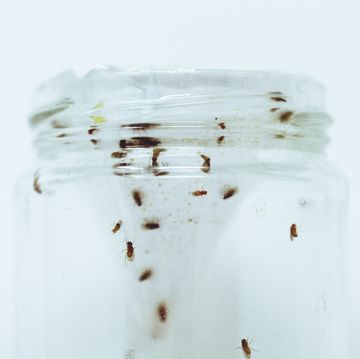You buy a new shirt, and suddenly you want to wear nothing else for the rest of the week except, obviously, the New Thing. And you want to start right away.
You have the same familiar conversation in your head: "So maybe a few other people tried this on before me, but it's fine. I don't really need to wash it immediately, do I? It looks so crisp in this packaging, it's wrinkle free and it's just waiting for me to wear it, now."
Before you toss the New Thing on your body and walk out the door, you might want to consider listening to another voice—that of Lana Hogue, a clothing manufacturing expert who teaches classes at Garment Industry 411. "You should absolutely wash clothes before you wear them, especially anything that is right next to the skin or that you will sweat on," says Hogue. Even if potential germs from fellow tryers-on don't faze you, the chemicals on the clothes themselves should certainly give you pause.
According to Hogue, almost every yarn or dyed fabric requires chemicals to make them into cute skirts or tops. Unfortunately, those chemicals can have side effects, like contact dermatitis, an itchy red rash that pops up anywhere the irritant came in contact near the skin. "Most of the chemicals used in dyeing fabric and putting those finishes on yarns that allow them to be processed through spinning equipment are known skin irritants," Hogue says.
According to Hogue, fabric makers use chemicals out of necessity. "Lots of people believe that clothing is treated with chemicals," she says. But it's not clothing necessarily that is treated, but the textiles." In most commercial environments, finished textiles are exposed to moisture. To prevent mold from sprouting up, yarn is sprayed with an anti-mildew agent, as well as chemicals that help the yarn slide through weaving machinery as it is transformed into fabric. To make dyes stick to fibers—so shirts and shorts can be in those royal blues and brilliant reds we all love—also requires a chemical treatment. "Even natural fibers require caustic chemicals," said Hogue. "Even if you buy a 100 percent cotton shirt."
As anyone who has studied the "made-in" labels on their purchases can attest, clothing comes from around the world, but components such as fabrics and trims are often stitched and dyed in a variety of countries, each with different laws about chemical use. Ingredients like azo-aniline dyes and formaldehyde resin are fairly common and cause skin irritation. "Formaldehyde is a category 3 carcinogen, which is the lowest hazard, and the amount is so small that it's assumed that it won't remain a threat for very long. But still, who wants to knowingly expose themselves over and over again to carcinogens?" asked Hogue. Even more alarming, a 2010 study conducted by the U.S. Government Accountability Office found some fabrics for sale exceeded the allowable levels of the formaldehyde's resin in the U.S.
Donald Belsito, a professor of dermatology at Columbia University Medical Center in New York, told The Wall Street Journal that the case for washing clothes extends from the textile manufacturing facility to the dressing room, which can be breeding grounds for bacteria, lice, and fungus because there's no way to really track who's tried on the clothes before you did. "I have seen cases of lice that were possibly transmitted from trying on in the store, and there are certain infectious diseases that can be passed on through clothing," he told WSJ.
Luckily, washing items before wearing them can dramatically decrease the likelihood of getting a rash or lice, or being exposed to some nasty chemicals. Pay close attention to anything that is worn next to the skin or prone to getting sweated on, like summer staples. On Hogue's must-wash list:
- Socks
- Underwear
- Undershirts
- Athletic wear
- T-shirts
- Shorts
- Summer dresses
- Swimsuits you don't plan to wear in the water immediately
"If you're going to wear it out and in the heat and sweat in it, you should launder it," Hogue advises. "Sweating opens your pores and allows your skin to absorb the chemicals in clothing."
There are a few kinds of garments that Hogue says you can skip the pre-wash on, like:
- Swimsuits, when you'll jump in the water in immediately after putting them on (that should be enough to rinse out anything too caustic, according to Hogue)
- Event wear ("You're not going to launder your prom dress")
- Outerwear, which isn't worn directly next to your skin
"If you have a tailored jacket, you're not going to want to wash it," she says. "It's not being worn right next to your skin and it's not going to give you skin irritation." Hogue also says not to bother sending anything that is marked as "dry clean only" promptly to the dry cleaner. "It's not going to do you a whole lot of good to go dry clean it, because then you are putting fresh chemicals in the fabric. But I would air it out before wearing it."
As for the other stuff, we get it: Spending time washing your new clothes instead of promptly showing them on is a bit of a buzzkill. But it's worth it. Quelling the instant gratification urge is a small price to pay if you don't want to expose yourself to unknown chemicals, or walk around sporting a brand-new rash along with your brand-new clothes.












